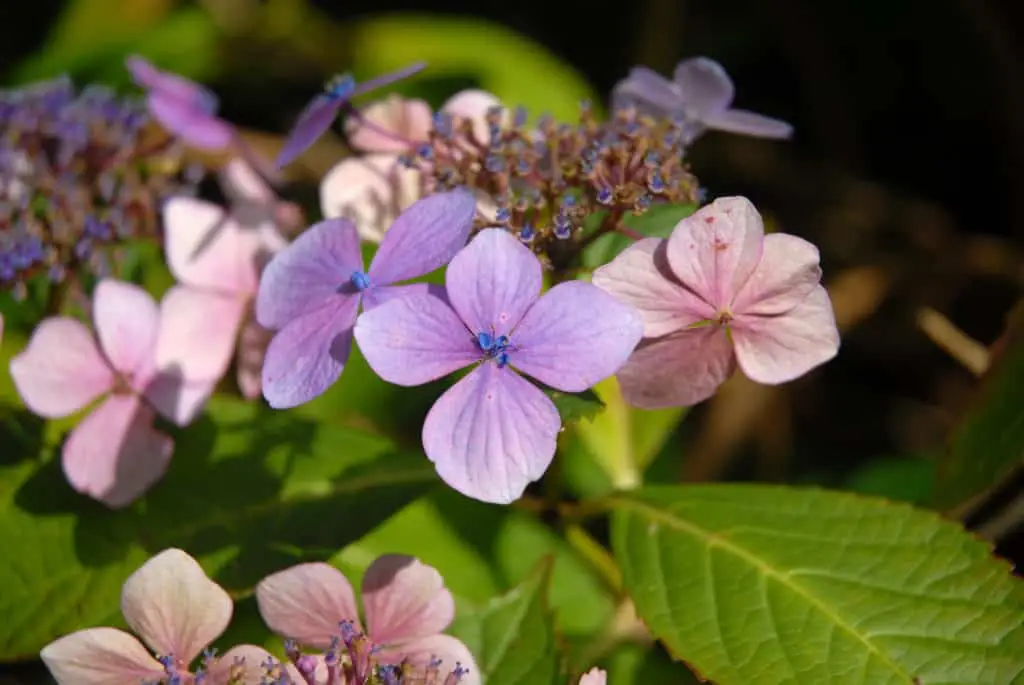In the spring and summertime in the south, it is hard to turn a corner without seeing stunning hydrangeas! Are you as enamored by these beauties as I am? I was lucky enough to move into a home with not one but 5 established plants! To make sure they continued to bloom, I had to do a little research and wanted to share what I learned here with you!
Different Varieties of Hydrangeas
With the cultivation of new variations happening all the time, there are arguments over the exact number of different hydrangea species. Numbers vary from 23 up to 80, but there are only 6 main species that are usually grown in American gardens. Let’s take a look at these beauties!
BigLeaf Hydrangeas
Bigleaf hydrangeas (Hydrangea macrophylla) are also known as mopheads, french hydrangeas, or hortensias. A popular well-known variety is called “Endless Summer.” These beautiful blue blooms may also be white, pink, blue, purple, or red. The thick iconic blooms are dubbed “mopheads” but may also be seen in a variety called a “lacecap” in which the petals are more dispersed among the bloom.

Smooth Hydrangeas
Similar in appearance to BigLeaf Hydrangeas, Smooth hydrangeas (Hydrangea arborescens) can tolerate colder temperatures and are found in zones 3-9. Their blooms can be white or pink and common selections are “Annabelle,” “Incrediball,” and “Invincibelle Spirit.” Smooth Hydrangeas will not tolerate drought though and must be consistently watered.

Panicle
Panicle hydrangeas (Hydrangea paniculata) cultivars include “limelight,” “Vanilla Strawberry,” “Pinkie Winkie,” “Grandie Flora” aka “PeeGees”, “Bobo,” and “Little Quick Fire.” These grow very large rather quickly and are characterized by large white cone-shaped blooms. Panicle hydrangeas can thrive in full sun and are hardy in zones 3-8. I have two of these in my yard and they are show stoppers in the summer!

OakLeaf
Chances are you have seen oakleaf Hydrangeas(Hydrangea quercifolia) growing in local parks or wild along nature trails. You guessed it- they get their name from their leaves that are shaped very similarly to the oak trees. Their blooms are cone-shaped and white to purple/pink. Their leaves turn beautiful fall colors also! Oakleaf hydrangeas are true natives of the U.S. if a pollinator garden is your goal!

Mountain Hydrangea
Mountain hydrangeas (Hydrangea serrata) look a lot like the Bigleaf hydrangeas but do not grow quite as large. This is a great choice if you are keeping your plant in a container. The blooms are similar in shape but on a smaller scale. Common names are “Blue Billow,” “Tuff Stuff,” and “Blue Bird.” These are hardy in zones 6-9 and the flowers bloom in blue and/or pink.

Climbing Hydrangea
Have you ever seen a Climbing Hydrangea (Hydrangea anomala ssp. petiolaris) in bloom among a tree or on the side of a home? They are gorgeous! Commonly called “Miranda,” these can grow up to 200 ft across and 60 feet climbing! They become quite heavy and may overpower a structure if not pruned. The blooms are beautiful white flowers!

Choosing A Hydrangea for Your Yard
If you want to begin growing these beauties in your own yard, the first thing you need to do is decide where you want to plant. Once you have an idea then you need to consider how much sun shines on that spot. The Hydrangeas listed above all have different needs for sunlight. For example, mophead hydrangeas in the Bigleaf family prefer more shade and only a few hours of sunlight and limelight hydrangeas from the panicle family prefer full sun. Where you want to plant dictates the type of hydrangea you will choose.
Pruning and Soil
Hydrangeas are perennial plants which means that if taken care of properly, they will come back year after year and reward you with beautiful blooms! Some owners complain though that their plants flowered beautifully one year but the next year…no flowers! Most of the time this is due to improper pruning, poor soil nutrition, or a sudden cold snap after the flower buds began to form.
When pruning hydrangeas you must learn whether your plant blooms on “new wood” which means new spring growth or if it blooms on “old wood” which means last year’s growth. New wood should be pruned in the fall during the dormant season and old wood should be pruned after spring/summer blooming. Be sure to research the type of hydrangea you are planting to know when the best time to prune is!
For some varieties, the color of the bloom can be influenced by the amount of lime or acidity in the soil. There are several different types of fertilizer to give you the best brightest colors you are desiring. If you notice your hydrangea blooms change colors on their own, it could indicate a need for some fertilizer.
Which variety is your favorite? We would love to see your big beautiful hydrangea blooms or anything you want to show off from your garden!
If you have a submission that you would like to share, send it our way!









